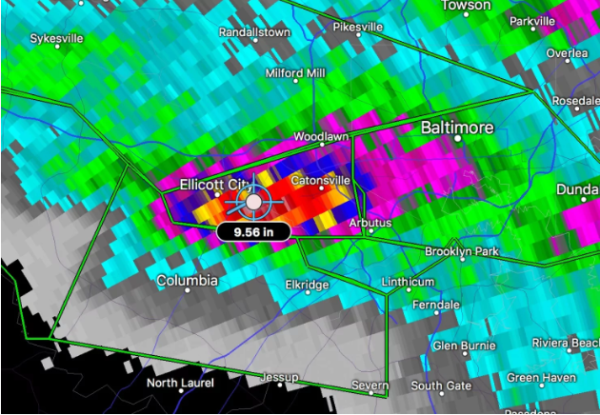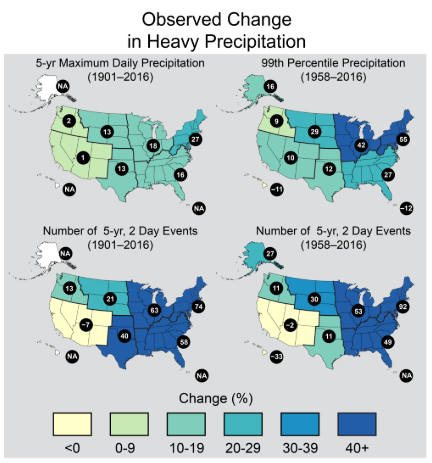How Climate Change Contributed to Ellicott City’s Back-to-Back Historic Flood Events
29
May, 2018
Back
when climates were more stable during the 20th Century, we would have
expected Ellicott City to see the type of severe
rainfall that occurred during 2016 to
happen once every thousand years or so. But with the
present global climate amped up by human forced warming,
just two years elapsed before another such ‘1 in 1,000’ year
event hammered the region yet again.
******
(Climate
change related factors that contributed to the second 1 in 1,000 year
flood event to strike Ellicott City within two years.)
Back
in 2016, a
massive thunderstorm complex dumped 6 inches of rain over the
Ellicott City region within just two hours.
The storm crippled the downtown of this historic city, severely
damaging more than 25 buildings, resulting in the loss of two lives,
and spurring calls for a moratorium on development in such low-lying
areas. This was the heaviest rainfall ever to hit Ellicott City on
record. And though the city had experienced floods before, it
had never seen so much heavy, short-duration, local precipitation.
Typically,
Maryland does not see such severe rainfall amounts. In a normal
climate, Ellicott City would expect to see such high rainfall totals
once every 1,000 years. However, the climate is no longer normal.
Atmospheric greenhouse gasses are now at higher levels than at any
time in at least 15 million years. The Earth is warming up.
Atmospheric moisture levels are rising. Severe
rainfall events are proliferating across the world.
And off the U.S. east coast, the
Gulf Stream is slowing down as Greenland disgorges more of its ice.
(The
second recent Ellicott City Flood dumped an amazing 9.6 inches of
rain within just three hours. Climate change increases the ability of
the strongest storms to generate more intense downpours by loading up
the atmosphere with moisture and by increasing instability in certain
regions. The Eastern U.S. is particularly prone to increasing
rainfall intensity due to a warming Gulf of Mexico, a warming North
Atlantic off the U.S. East Coast and due to an instability-generating
cool pool off Greenland fed by glacial melt water. Image
source: Radar
Scope and The
Washington Post.)
The
Eastern U.S., in particular, is seeing increased potentials for heavy
precipitation as a climate change related cool pool off Greenland is
causing polar
air masses to come into conflict with rising heat and increasing
levels of atmospheric moisture streaming up from both the Gulf of
Mexico and the middle Latitudes of the North Atlantic.
As
a result, the chances that Ellicott City would see another historic
severe storm of this kind were greatly increased. So much so that the
region was hit again on May 27 of 2018. This time by a storm that
was more severe than the one that occurred during July 30 of 2016.
(Due
to human-forced climate change, the intensity of rainfall events,
particularly in the strongest storms, is increasing across the U.S.
with the greatest increase over the eastern half of the country. This
record of increasingly severe rainstorms due to human-forced climate
change isn’t just limited to the U.S. It
is a global phenomenon.
Image source: The
National Climate Assessment and Katherine
Hayhoe.)
This
larger flood dumped
9.6 inches of rain just east of Ellicott City within only three
hours.
Hourly rainfall amounts during this event likely exceeded 4 inches at
the storm’s peak intensity. And a new wave of massive flooding
ripped through the historic district — re-damaging buildings that
were on the verge of recovering and
again resulting in loss of life.
Unfortunately,
the climate dice are now loaded for more such ‘1 in 1,000 year
events.’ So what happened in Ellicott City this weekend should not
be attributed to some ‘fluke local weather event.’ Climate change
increases the potential for these kinds of storms. So we’ll see
more and worse such instances as we keep warming up our atmosphere,
heating the oceans, and melting glaciers.


No comments:
Post a Comment
Note: only a member of this blog may post a comment.